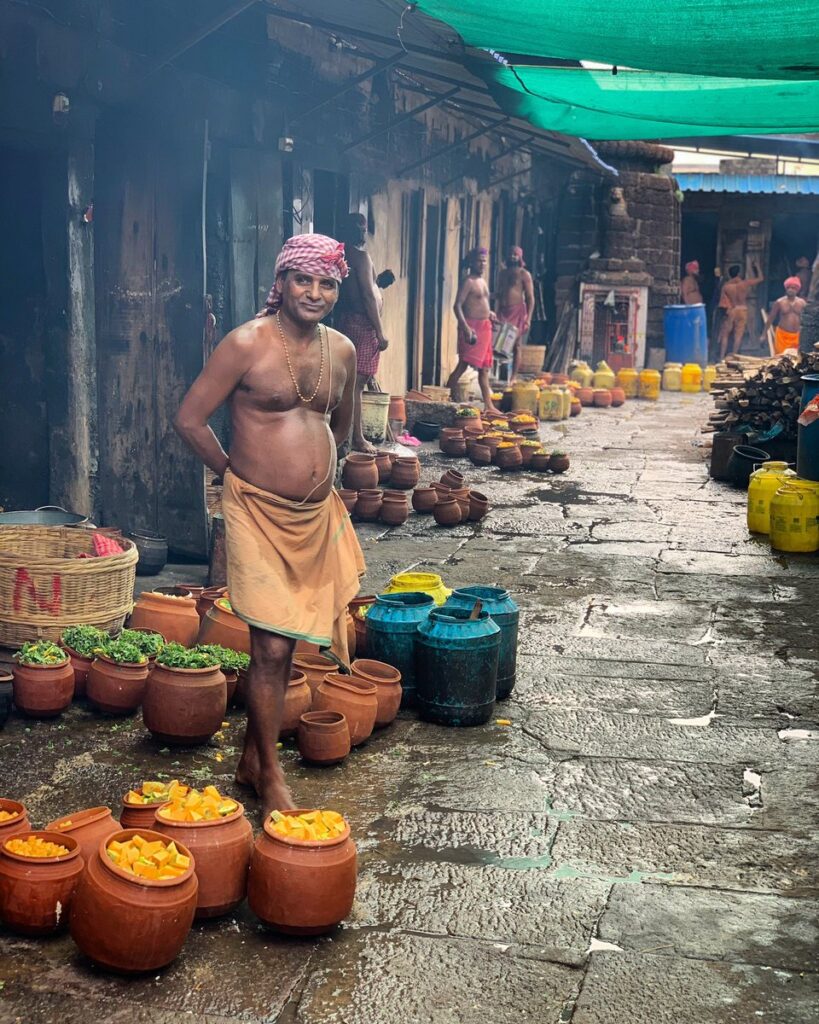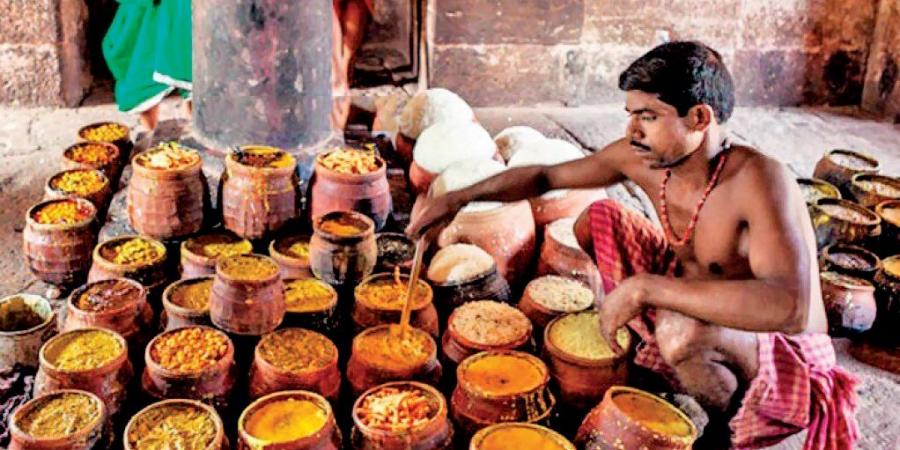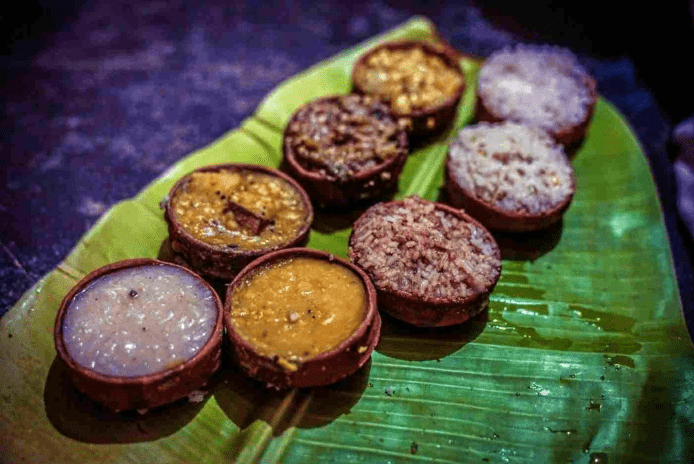About The Author
Hello! From Chuchura (in Hooghly District) and a foodie, I created this blog with a mission to preserve the food of the land; with a message to encourage and promote clean and real food. I hope you enjoy and gain out of this blog, happy reading!
Looking forward to read and hear your feedback.
The culture of a region has an intrinsic connection with its food. And if you have been to Odisha, you will know that the food of Jagannath Temple at Puri, Odisha has defined the food habits of the the region for centuries.
The sea beach of Puri and the 12th century temple are one of the most popular tourist spots and perhaps the most visited religious place in Eastern India.
And to the people of Odisha and it’s neighboring state Bengal, the mahaprasad at the temple tops the list of priorities after a darshan in the temple.
The Mahaprasad & Abhada
The temple kitchen can feed anywhere between Five Thousand on a normal day and more than One Million on special occasions. The set up remains the same through out the year and the customs, never change.
The mahaprasad is also called Kaibalya known to provide moksha (liberation from sins) and the pot containing the mahaprasad is called as Abhada. Abhada means everlasting.
Anna Khestra Puri – The Legend
Legend has it that Lord Jagannath was initially worshipped as Neelamadhava or the Blue God in the Nilachala Hills of Odisha.
The tribal chief of the hill, Biswabasu had kept the blue radiant idol of Krishna hidden in a cave. During worship, he would offer the Deity fruits and flowers. There were no rice paddies or vegetable fields in the hills.
Every morning when Biswabasu arrived at the cave with his offerings, he would surprisingly find huge quantities of rice dishes and curries.
It is widely believed that the Gods and Goddesses would reach the caves at night to have a darshan of the Lord and in turn offer dishes made of rice, vegetables, pulses and sweets.
Rice is a staple food in Odisha and Bengal, and the huge amount of rice cooked in the temple makes Puri the Anna Khestra (Rice area). No other religious sites on Planet Earth sees such huge quantities of rice being offered as prasad and served as mahaprasad.
Chhappan Bhog
On a given day, Lord Jagannath along with his siblings (also called as The Trinity) are served 56 items, also called as “Chhappan Bhog“.
The food can be categorized as rice preparations, lentils, curries and sweet meats. Certain food items are prohibitied–
- Potato
- Tomato
- Dried Chili
- Oil
- Cabbage
- Cauliflower
- Carrot
- Long Beans
- Drumsticks
- Lady’s Finger or Okra
- Onion
- Garlic
- Refined Sugar
- Gourds like bitter gourd and bottle gourd
The Mahaprasad preparation are categorized into two parts –
- Kotho Bhog – Prepared at the cost of temple administration and given to sevaks
- Baradi Bhog – Prepared for sale at the Ananda Bajar (food market of the temple) for pilgrims and visitors at the temple
The Trinity is offered food at Six different times of the day. The food is served in fixed quantities
- Gopal Bhallabh or Breakfast at 8:30 AM which is a 7-item uncooked treat
- Sakala Dhupa or Morning Meal at 10:00 AM is the first cooked meal of the day
- Mandapa Bhog or Supplementary Breakfast at 11 AM which was first introduced in the 8th Century by Adi Sankaracharya to help pilgrims arriving at the temples with food
- Maddhyanna Dhupa or Lunch between 12:30 AM to 1:00 PM
- Sandhya Dhupa or Evening Meal between 7 PM and 8 PM after the evening aarati
- Bada Singhara Bhog or Late Night Meal at 11:15 PM after singing the Gita Govinda
There is an additional serving made when the sun stays in the zodiac sign Sagittarius. Known as the Pahili Bhog, it is offered just before sun rise.
Legend has it that the Pahili bhog (a special khechedi or khichuri/khichdi) is prepared by Shri Krishna’s mother Yasodha as Mahalakshmi moves to her father’s house.
The Kitchens of Lord Jagannath Temple
There are three kitchens in the Lord Jagannath Temple at Puri.
- That cooks food for Goddess Mahalakshmi, called as Bahara Deuli Rawsa Griha. Also served to other Deities
- That cooks food for the Sun God or Surya
- The largest kitchen is reserved for the Lord of the Universe, Shri Jagannath
The kitchens of Lord Jagannath is considered as the largest kitchen of the world covering an area of tens of thousands of square feet
Local beliefs say that Mahalakshmi is the Head of the Kitchen and she cooks the food which is served to the Lord Jagannath and his siblings and then to Lord Bimala.
The Kitchen contains 32 rooms with 250 earthen ovens and 9 kitchens. The preparations before the cooking happens, involving cutting, chopping and grinding, etc. are done in front of the kitchens in a large open courtyard, also called as the agana.
The kitchen compound contains several storage areas
Before the cooking starts, a ritual known as the Rosa Homa is done. This happens around 8 AM every morning.
Fire & Fuel
The main fire at the Kitchen of Lord Jagannath, also called as the Vaishnava Agni is always kept on and never put off.
The fuel is mostly wood and charcoal. The wood for cooking is provided by the Odisha State Forest Corporation and as per customs of the Temple Kitchen, it should be free from any insect attacks. Some of the wood from the chariots (from the Ratha Yatra) are also used for cooking.
While wood is only used for cooking rice preparations, charcoal is also used to cook lentils and curries.
Stoves and Fireplaces
There are 752 clay stoves and form a shape that look like lotus. These stoves are also called chulis and have fixed dimensions.

Jhinkas or clay knobs are carefully designed and thoughtfully placed to help accommodate pots of several sizes.
Nine pots are placed on top of one other, supported by the jhinkas receiving equal heat from the same wood fire below. This helps to cook the food in these 9 pots equally and evenly.
A practical example of conduction demonstrated hundreds of years before Joseph Fourier first formulated formulae around 1810.
There are three type of fireplaces in the kitchen, depending on what is cooked-
- Anna chuli to cook rice and rice based preparations
- Ahia chuli is a rectangular stove created in the space between two rice stoves, used to cook lentils and curries
- Pitha chuli to prepare pithas
Utensils & Pots
Only earthen pots (also called kuduas) are used for cooking purposes in the kitchen.
As per the rule in the kitchen, an earthen pot can not be reused. This ensures hygiene. New pots need to be continuously made and physically transported to the temple premises by 300 potters working under the banner of Kumbhara Nijogo Sangha.
The potter wheel has the impression of lotus and wheel, signifying the presence of Mahalakshmi and Vishnu. The potters should ensure that the pots are devoid of human hair, nails, worms, snails, etc.
These pots have excellent heat retention properties keeping the food hot for at least five hours. Cooking in earthen pots ensures a distinct aroma to the food giving it a hint of earthiness.
Apart from pots, the vessels are of two types. Kuduas are used to serve rice, lentils and curries while Oli is used to serve sweets. The kuduas and olis have different dimensions and named after several Mathas of Puri, with interesting stories.
Water Needs
There are nine wells or kuas inside the temple premises, out of which two are used to cater to the kitchen needs.
The Ganga Kua is square shaped and the Yamuna Kua is circular. Both these wells serve the kitchen needs.
The other wells or kuas are used for the temple’s needs like the daily rituals of the Lord Jagannath and gardening, among others.
Notably, the well in the Ananda bajar or Ananda Bajar kua is open for public use.
The Chefs & Helping Hands
As you already know by now, the Head Chef is assumed to be Mahalakshmi (who cooks for Lord Jagannath) and everyone else works under.
Legend has it that King Indradumnya was offered a boon by Lord Bramha. The king requested that the offsprings of Lalita be allowed to cook food for the Lord as suaras.
There are one thousand cooking assistants in the kitchen divided into three groups based on their responsibilities in the kitchen area. All the assistants are well fed before the cooking process to ensure strength and no hunger, while food is being cooked for the Lord.

Five hundred executive chefs or suaras are the only ones who are allowed to cook food on the stoves in the kitchen.
Three hundred assistants called as jogania assist the suaras or executive chefs by performing various tasks like lighting the fire, getting water from the wells, washing and cleaning of the earthen pots and vessels, and then filling in them with the ingredients – raw rice, lentils, vegetables, etc.
The remaining two hundred assistants are called tunias. They are the second string of helping hands who are not allowed to enter the kitchen but work from outside of it (the open courtyard), and help in washing and cleaning of the raw ingredients, cutting and chopping them, grating coconuts or grinding spices.
There are also mahasuaras, who are responsible to carry the food from the kitchen to the offering area, by resting the middle of a bamboo pole on his shoulder while a stack of pots are tied to the two ends of it.
These days, however, most carry the pots on their shoulders.
Interesting to note, that their training start from the age of twelve and they serve the kitchen of Lord Jagannath till the end or till they are too old to perform their duties.
Ananda Bajar – The Food Mart of Mahaprasada
Perhaps the biggest hotel of the world as it can cater to the food needs of up to 1 million or 10 lakh devotees. The word ‘Ananda Bajar‘ meaning ‘Contentment Market’ came into being in the 18th century, before which the Mahaprasada was sold near the main entrance of the temple, also called as Simha Dwara (or Lion’s Gate).

The mahaprasada consisting of both food and drinks offered to the Lord is sold fresh at any point of the time (from dawn to dusk) in the huge open space that has dining halls with water facilities.
As per the tradition, you are supposed to sit cross-legged on the floor and eat the food on plantain (banana) leaves, a custom that is also prevalent in many other Hindu temples across India.
The Ayurveda Connection
The cooking in the temple and food adheres to the ayurvedic principles. The food is satvic, which means it is an all vegetarian affair without the use of onion and garlic.
The food is cooked while ensuring a balance of all the six tastes mentioned in Ayurveda – sweet, sour, salty, pungent, bitter and astringent.
Ghee is used to cook all meals and oil is prohibited. Other essential ingredients used include rice, jaggery, neem, turmeric, milk, ginger, mustard seeds, black pepper, cumin and coriander. Each of these ingredients have important use in the well being of a person according to Ayurveda.
Cover Pic: Source


kudos to your efforts about the detailed description you have written…
I appreciate the time and effort you put into crafting this informative piece . This blog really captures the essence of the Kitchen of the Lord.
Thank you for sharing the information and depth of knowledge on this topic.
I am looking forward to reading more from you.
Pingback: Panch Phoron Diye Macher Jhol - A Summer Fish Curry from Bengal